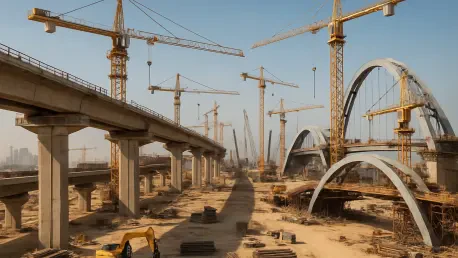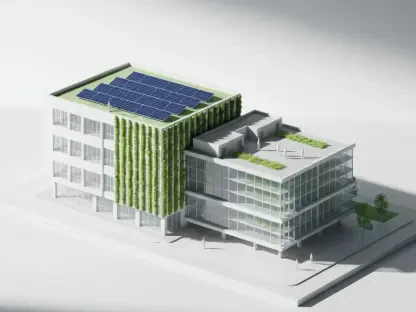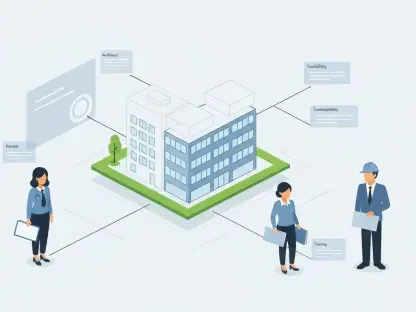I’m thrilled to sit down with Luca Calarailli, a seasoned expert in construction, design, and architecture, who brings a wealth of knowledge and a passion for innovative technology in the industry. With years of experience navigating the complexities of large-scale projects, Luca offers unique insights into the trends and strategies shaping the future of construction. Today, we’ll dive into the remarkable performance of a major contractor, exploring their record-breaking backlog, strategic maneuvers around economic challenges, and the outlook for ambitious infrastructure projects. Join us as we unpack what’s driving success in this dynamic field.
How would you describe the recent financial and operational performance of a major contractor like Tutor Perini in their latest quarter?
Well, Julien, I’d say their performance in Q2 2025 has been nothing short of impressive. From what I’ve seen, they’ve achieved one of their strongest quarters ever, with revenue climbing significantly—up 22% from last year to $1.37 billion. That’s a clear sign of robust growth. Their net income also jumped from just $800,000 in the same period last year to $20 million, which shows they’ve turned a corner on profitability. Compared to previous years, where they faced substantial losses due to project disputes, this quarter reflects a much smoother execution and a focus on higher-margin work. Their biggest win, in my view, is the doubling of their backlog to a record $21.1 billion, which signals tremendous future potential.
What do you think is fueling such a massive increase in their project backlog to $21.1 billion?
The surge in backlog is really a combination of strategic positioning and market dynamics. They’ve clearly capitalized on a trend toward megaprojects—those multibillion-dollar infrastructure jobs that many contractors shy away from due to the inherent risks. Sectors like civil infrastructure, where they’re seeing profit margins climb to around 15%, are likely a major driver. I’d wager that specific projects, such as their work on high-profile transit and rail initiatives, are contributing heavily. This backlog isn’t just about volume; it positions them as a leader in a space with limited competition, allowing them to be selective and focus on contracts with better terms and profitability.
They’ve called this one of their best quarters ever. What elements do you believe made it so exceptional?
I think it boils down to execution and timing. From what’s been shared, their project ramp-ups happened faster than anticipated, and they’ve avoided the typical snags that plague large-scale jobs. Often, contractors build in contingencies for delays or cost overruns, but in this case, they’ve only used a fraction of that buffer, which speaks to the team’s efficiency. I suspect some key projects exceeded expectations, perhaps in terms of early milestones or cost control. It’s also about the groundwork laid over years—resolving older disputes and focusing on newer, more profitable work. That discipline is paying off now in a big way.
The company also raised its earnings guidance for the year. What factors do you think gave them the confidence to make such a move?
Raising guidance is a bold statement, and it likely stems from a combination of operational success and visibility into future performance. I’d say it’s driven by the smooth rollout of major projects, where they’re seeing quicker progress and fewer hiccups than planned. There’s probably also a boost from smaller jobs wrapping up ahead of schedule, adding to their bottom line. This kind of adjustment signals to investors that management trusts their trajectory—something rare, as it’s only the second time they’ve done this historically. It reflects not just current wins but a belief that their strategy of selective bidding and cost management will keep delivering.
Looking further out, there’s optimism for even higher profits in 2026 and 2027. What’s your take on what’s driving this positive outlook?
The optimism for 2026 and 2027 is likely tied to the lifecycle of their current backlog. Many of these major projects are just starting, and as they move into full execution, the revenue and profit potential will scale up significantly. I’m guessing they’re banking on sustained demand in infrastructure, especially with public funding remaining strong for key sectors like transit. Market trends, such as reduced competition on megaprojects, also play a role—they can command better margins. To sustain this, they’ll need to keep refining their project management and invest in tech for efficiency, something I’m passionate about seeing more of in our industry.
Unlike some competitors facing tariff challenges, this contractor seems unaffected. How do you think they’re managing to dodge these economic pressures?
It’s all about foresight and strategy. They’ve likely locked in costs for materials and labor well in advance on their major projects, which shields them from price spikes due to tariffs. For instance, buying steel or other critical supplies early means they’re not exposed to sudden increases. This approach takes discipline and strong relationships with suppliers. It’s a smart move in an era of economic uncertainty, and it shows they’ve learned from past volatility. For future bids, I’d expect them to factor in potential cost hikes upfront, passing that risk to project sponsors rather than absorbing it themselves.
On the topic of tariffs, they’ve expressed confidence that there won’t be impacts even in the future. How realistic do you find this stance?
I think their confidence is well-founded, but not without caveats. By re-evaluating tariff risks regularly and securing costs early, they’ve minimized exposure on current projects. Challenges like rising steel prices can still sting if a project timeline stretches unexpectedly, but their proactive approach helps. Looking forward, the strategy of embedding higher costs into bids is practical—it shifts the burden away from them. Still, they’ll need contingency plans for unforeseen policy shifts or supply chain disruptions. Staying agile with sourcing and maintaining a diversified supplier base will be key to keeping this confidence intact.
Let’s shift to their work on a significant rail project in California. With federal funding cuts looming, how secure do you think their position is on this job?
Despite the federal funding reductions, I believe their position on the California high-speed rail project remains solid for now. They’ve received assurances from the client that their specific $3.55 billion contract is funded and authorized, which is a strong indicator. Infrastructure projects like this often have layered funding sources—state and local commitments can buffer federal cuts. However, broader economic or political shifts could still introduce uncertainty. Their ability to maintain open dialogue with stakeholders and adapt to funding changes will be critical to keeping this project on track.
What’s your forecast for the construction industry’s trajectory, especially for contractors handling megaprojects like these?
I’m optimistic about the industry’s trajectory, particularly for contractors focused on megaprojects. The demand for large-scale infrastructure—think transit, energy, and urban development—isn’t going away; if anything, it’s growing with urbanization and climate goals. For companies like this one, with a massive backlog and a knack for navigating complex jobs, the future looks bright. Reduced competition in this niche means they can prioritize quality over quantity in their bids. However, challenges like labor shortages, material costs, and regulatory shifts will persist. My forecast is that success will hinge on adopting technology—things like AI for project planning and modular construction—to boost efficiency and manage risks. It’s an exciting time, but it’ll reward those who innovate.









